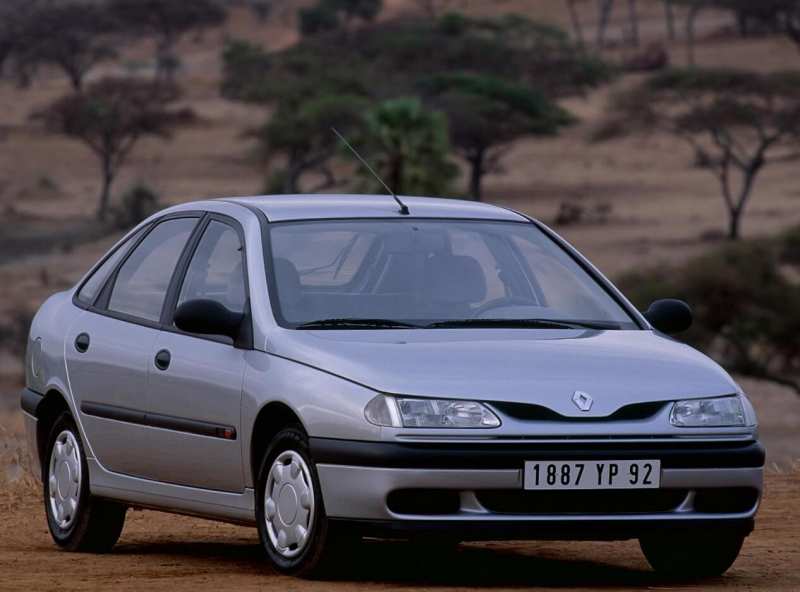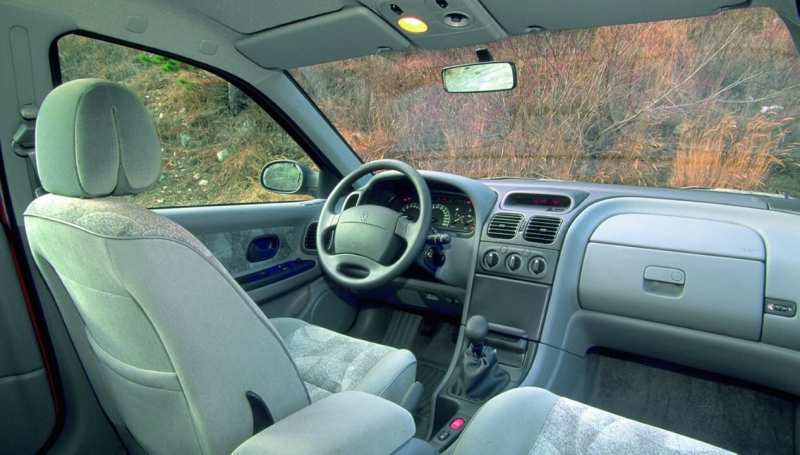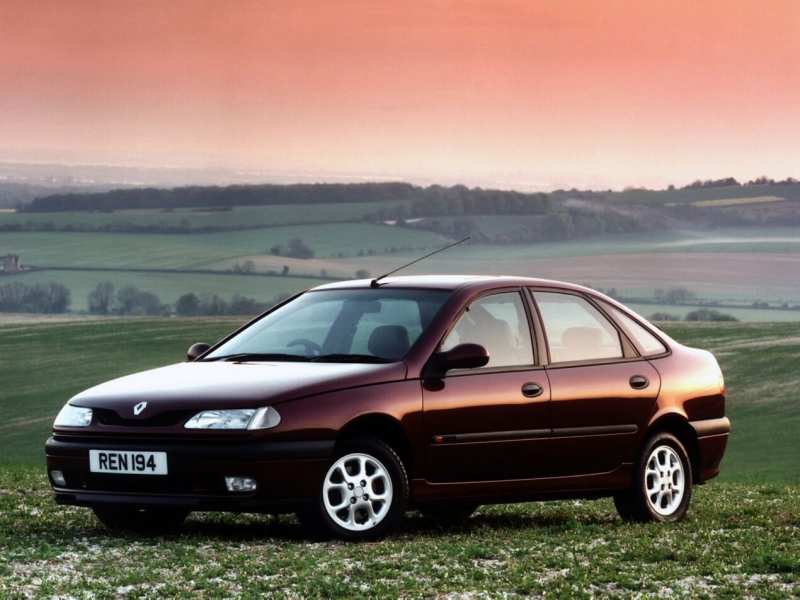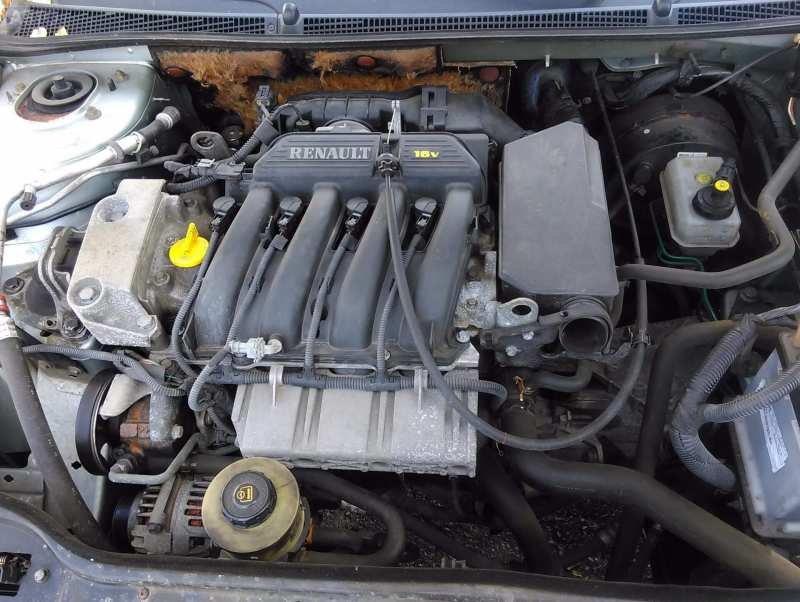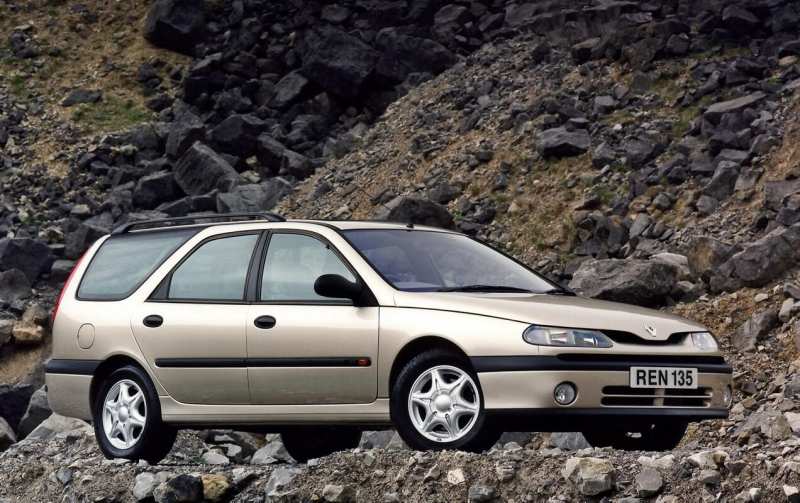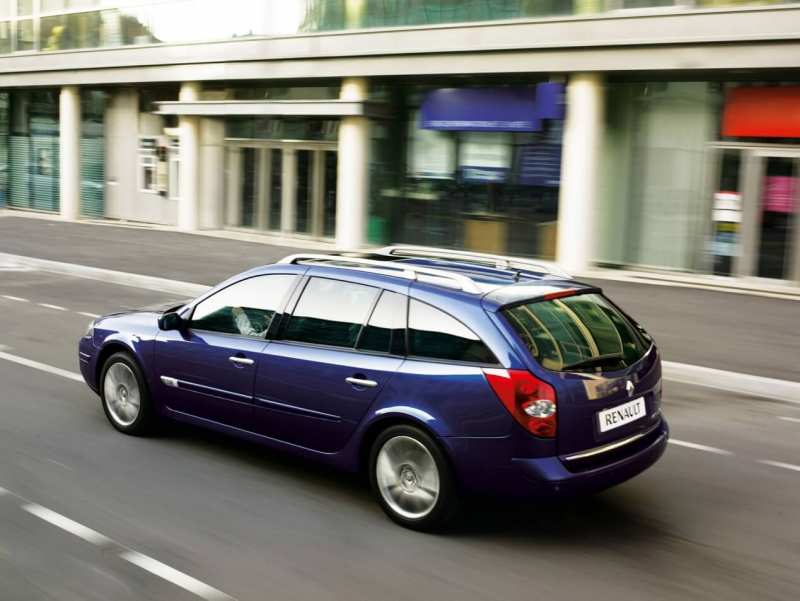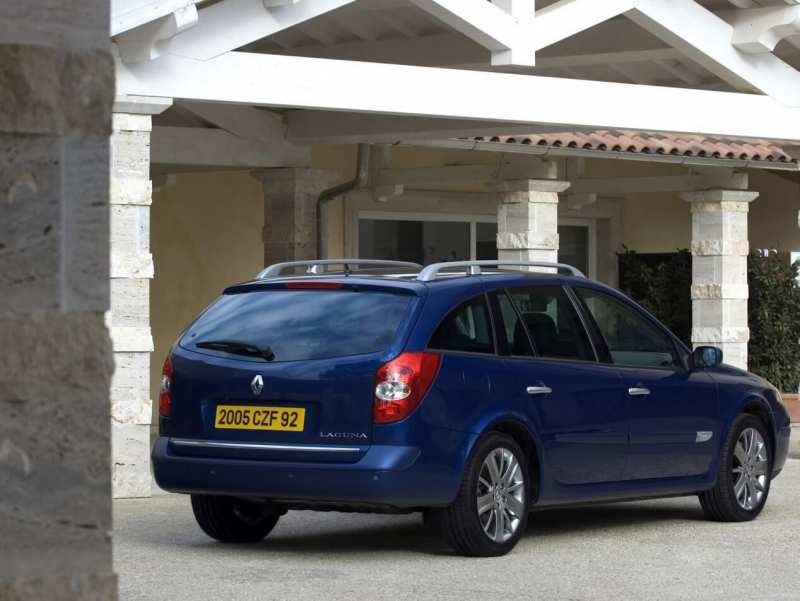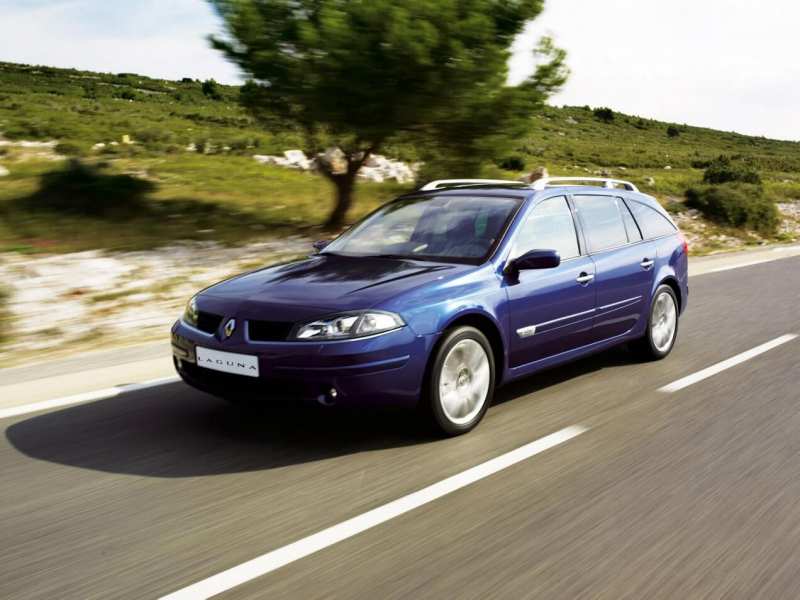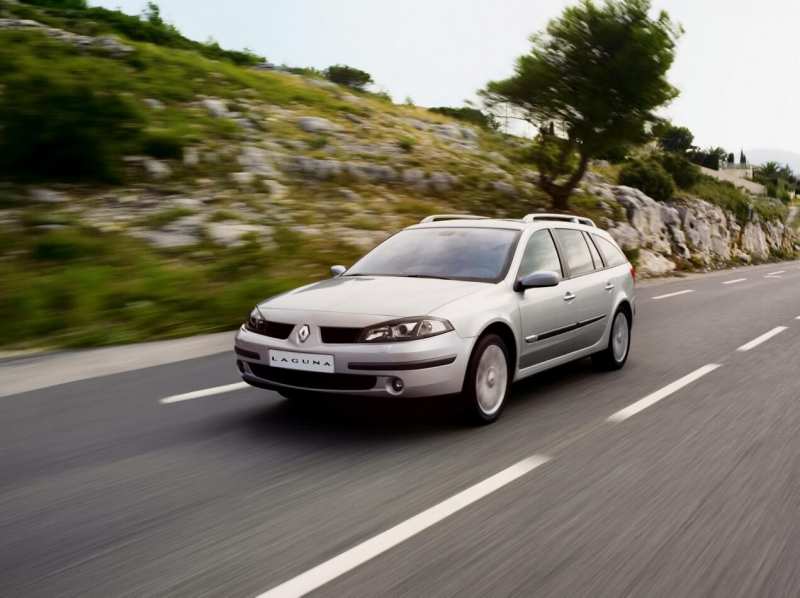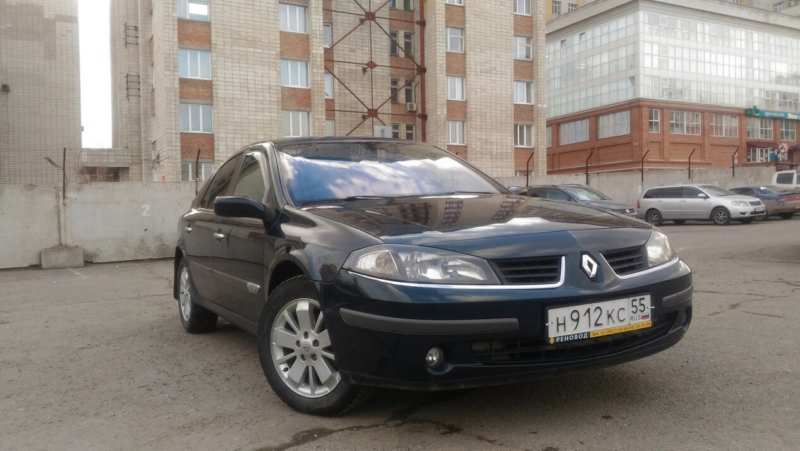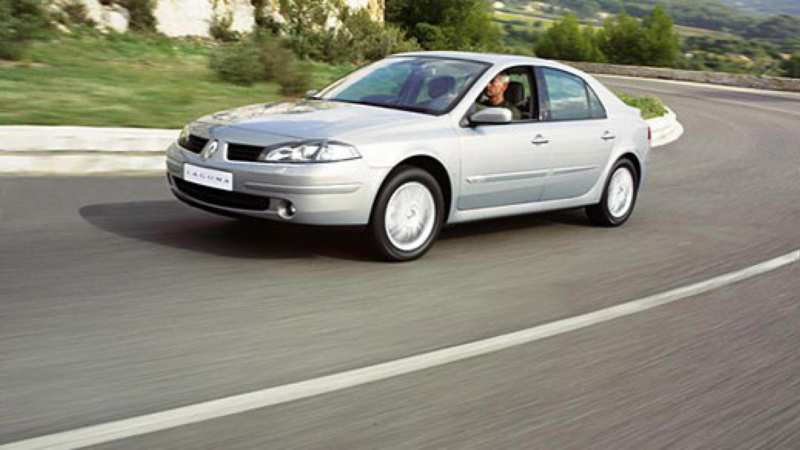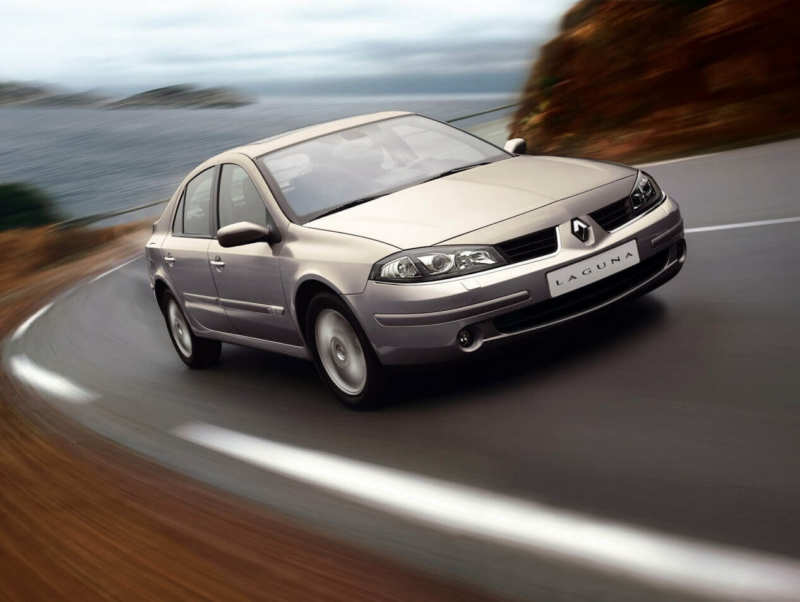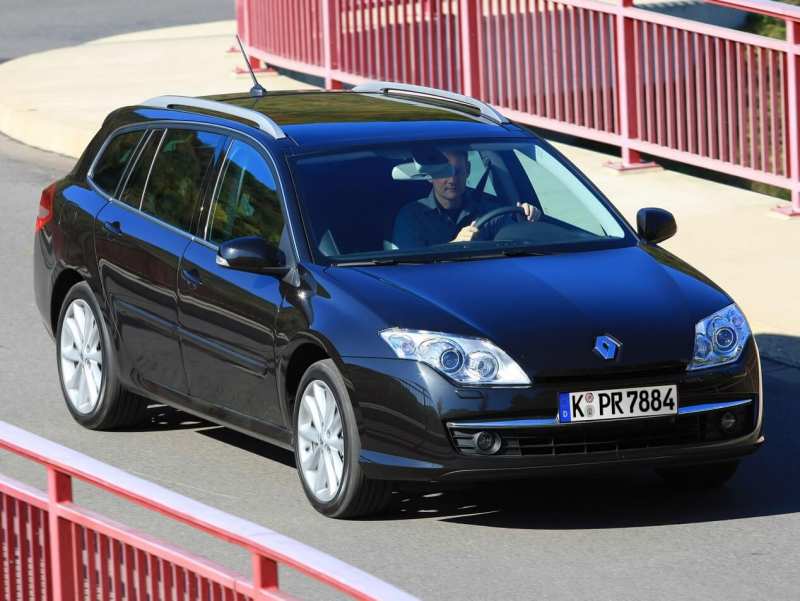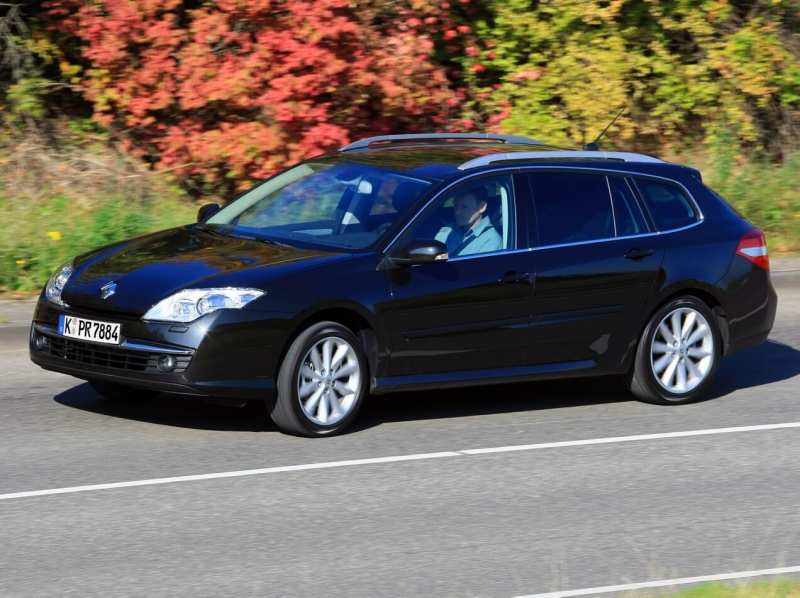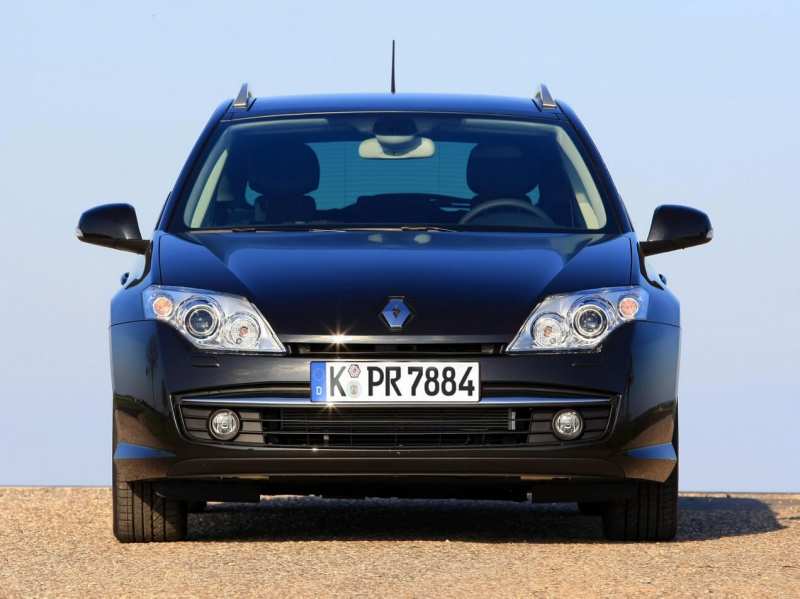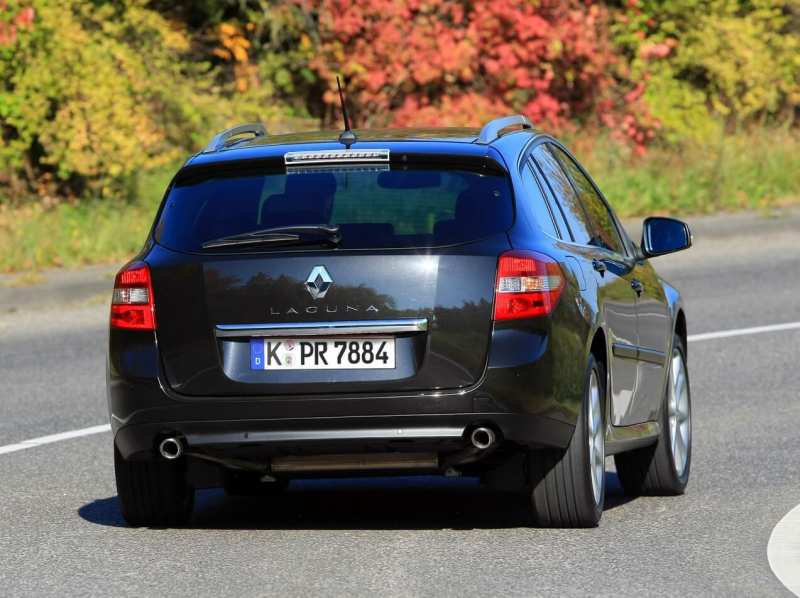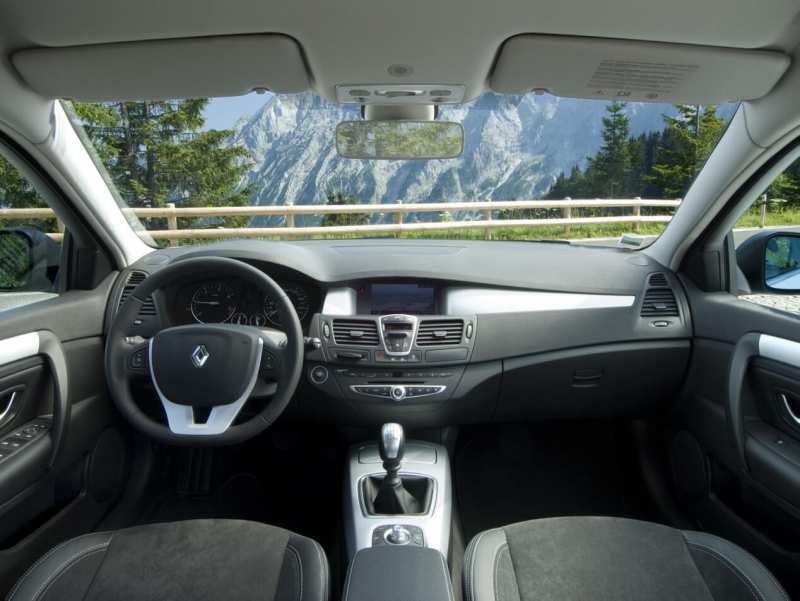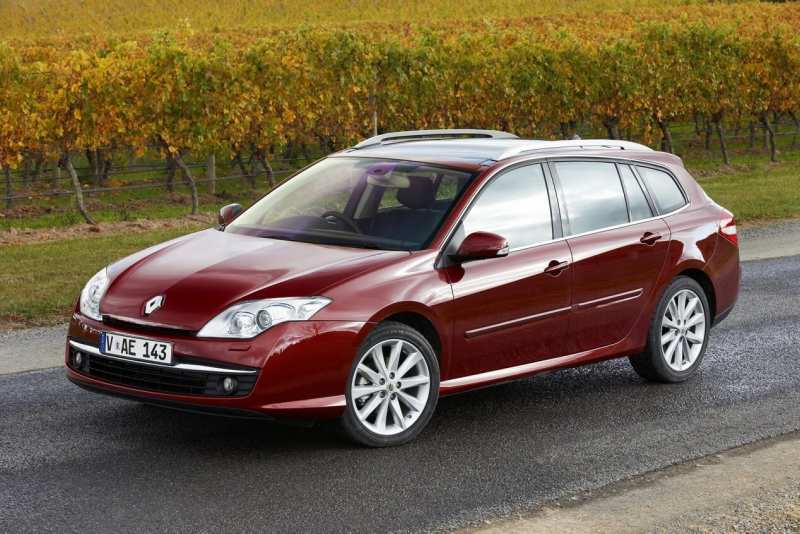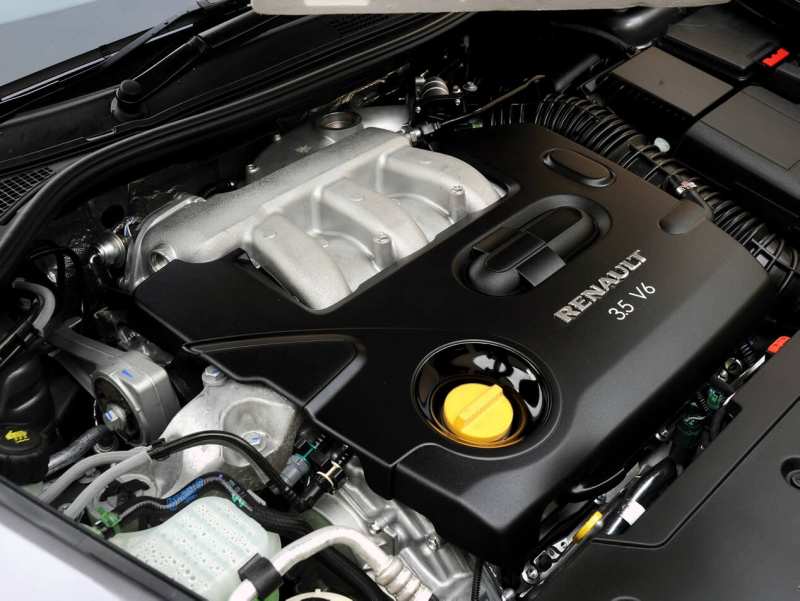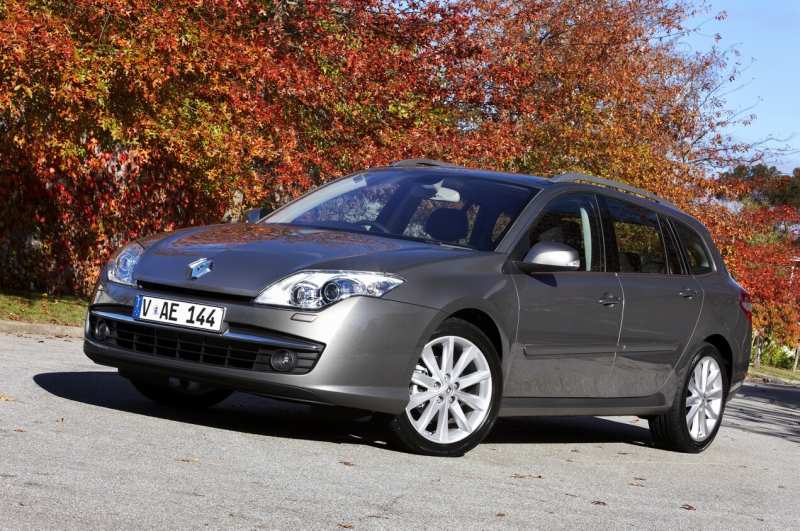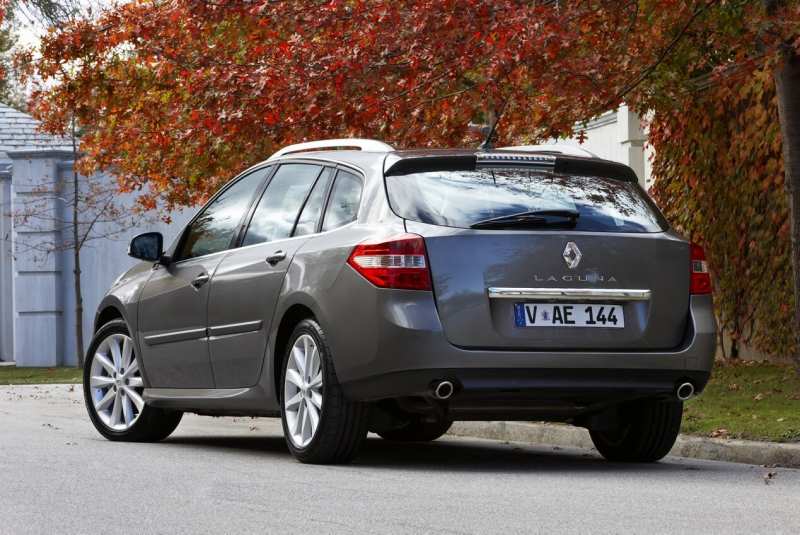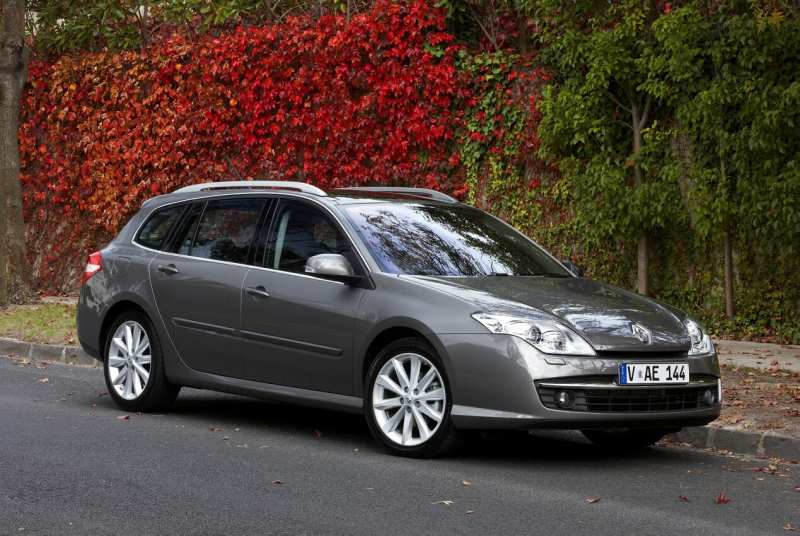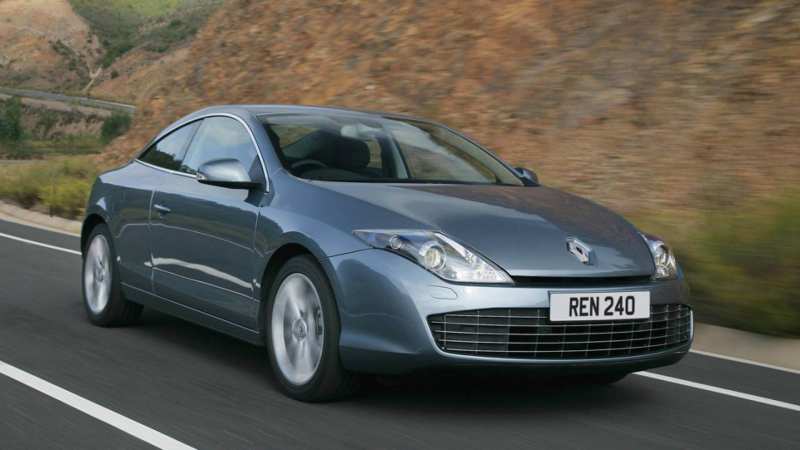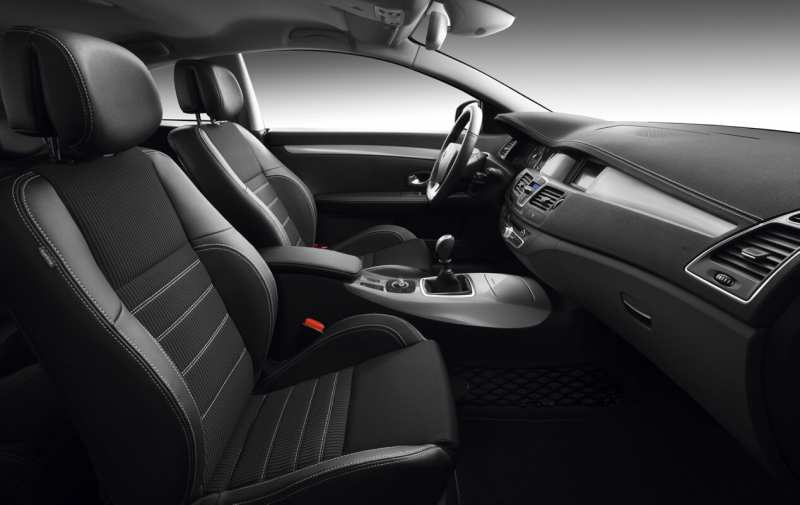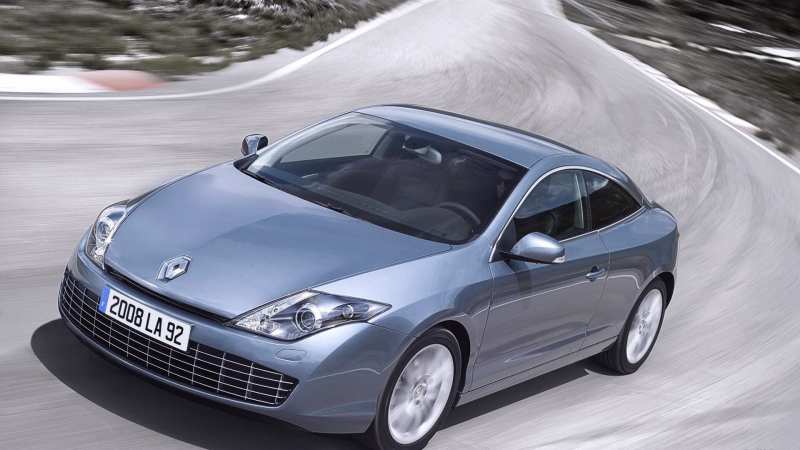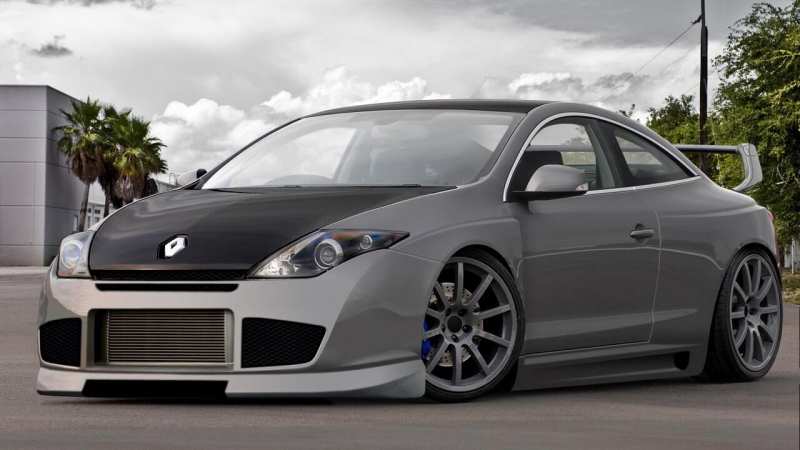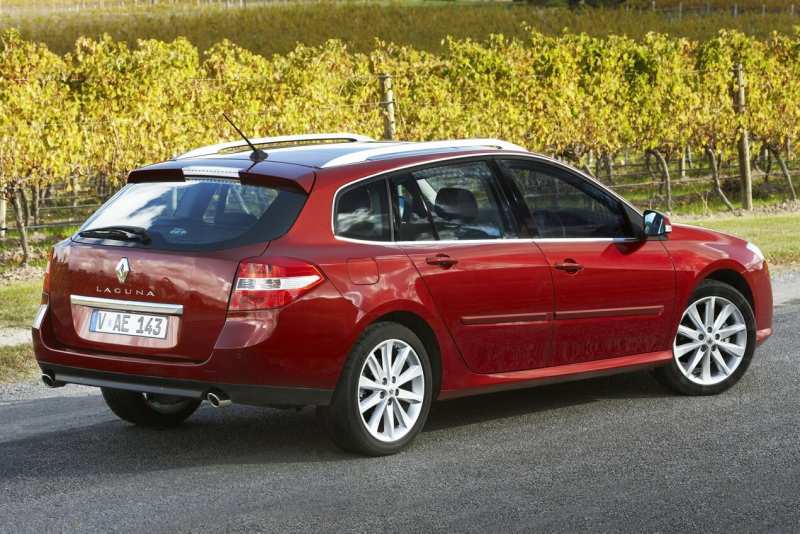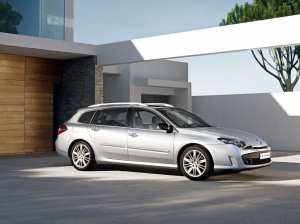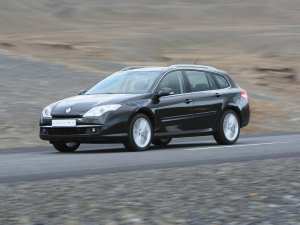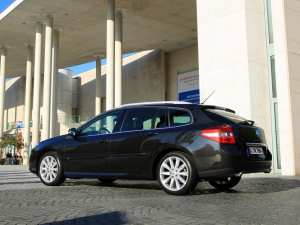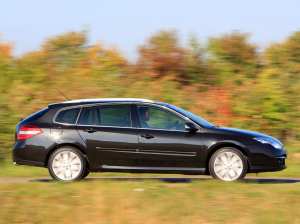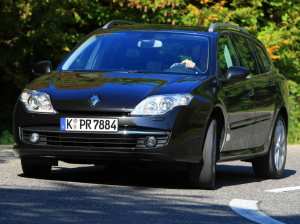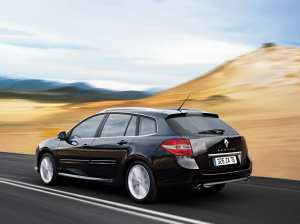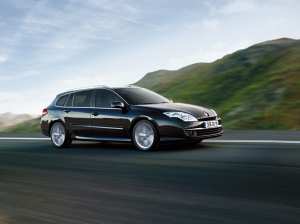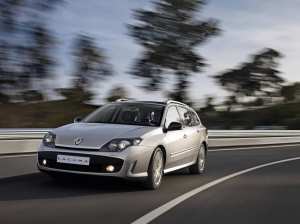Renault Laguna
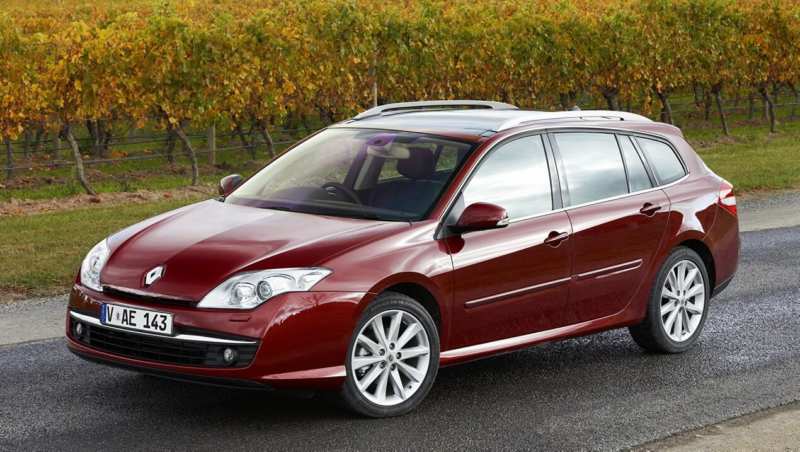

- Car model: Renault
- Producing country: France
- Year of issue: 1994
- Body Type: Hatchback, Station Wagon, Сoupe
Renault Laguna is a medium-sized car of the French company Renault. The debut family of this model was released in 1994. The second generation came out in 2001, and the third family began to sell in 2007. The whole model range is Renault.
- Car history
- I generation (1994-2001)
- Exterior I generation
- Interior I generation
- Technical part
- II generation (2001-2007)
- Appearance of the Laguna 2
- Laguna 2 salon
- Specifications
- Safety
- III generation (2007-2015)
- Exterior III generation
- Interior III generation
- Specifications III generation
- Powertrain
- Transmission
- Running gear
- Safety III generation
- Price and equipment
- Renault Laguna’s updated coupe
- Tuning
- Comparison with competitors
- Reviews from the owners
- The pros and cons
- Results
- Renault Laguna photo
Car history
The French Renault Laguna has replaced the tasteless and unattractive Renault 21. The car was positioned as a family vehicle. The novelty was produced at the French factory in Sandouville. The Renault Laguna was assembled in 1993, and sold in January 1994.
Initially, the car was offered only in the back of the elevator, but in 1995 the list included a Renault Laguna station wagon. It is noteworthy that for this model it was possible to install additional “children’s” chairs of 3 rows as a separate option.
I generation (1994-2001)
As mentioned above, Renault Laguna 1 replaced Renault 21. The first generation of the French family car has a revolutionary design. Very interestingly, that even today such appearance of the car looks fresh and modern. After a short time Renault Laguna 1994 became one of the most sold family cars in European countries.
From the very beginning the car had only a body liftback, but a year after the presentation, the public was presented a version of the universal (Grandtour). The debut Renault Laguna family is also equipped with a galvanized body and reliable corrosion protection.
Exterior I generation
Renault Laguna I generation is quiet, measured. The front part has narrow headlights and a small radiator grille, which is a little bit in the central part of the hood. The front bumper in the centre also has small air holes. On the sides of the Renault Laguna 1 front bumper there are round fog lights.
Over time, the headlamps scratch and blur, which affects not only the aesthetics, but also the practical aspects of the road surface – the quality of the road surface illumination is reduced. A glance into the profile also shows smooth and calm lines. There is not even a hint of sporting qualities, and they are not needed here. The glass is quite large, so the inside of the car is light and cozy.
The side mirrors are devoid of rotation repeaters and painted black. The window sill line rises smoothly to the rear of the Renault Laguna Hatchback. The rear part has massive rear lights, which are very quick to notice.
Between the two rear light plafonds, the French experts have installed a niche under the license plate. The rear window has a large glazing area. A small spoiler placed by Renault designers on the rear door also decorates a little.
Interior I generation
The inner part of the first generation of Renault Laguna received positive feedback. The seats are soft and wide, and the interior courageously endures the test of time. However, this does not apply to the steering wheel, as the lacquer comes off the skin, as well as erase the inscriptions on the buttons. Some reviews of Renault Laguna 1 owners say about low-quality ventilation system. When the windows are cold, they sweat despite the fact that the cabin filter is replaced.
The driver is presented with a medium size four-spoke steering wheel. Behind it there is an instrument panel. French engineers gave the left part of the dashboard to the tachometer, and the speedometer is installed in the center. The right part is allocated for the temperature sensor of the power unit and the fuel level sensor. On the left side of the dashboard Renault Laguna 1 generation is an elongated compartment for trifling.
There are 2 ventilation system deflectors on the central console, which are square-shaped with rounded edges. Above there is a small screen of the on-board computer. Interestingly, the door itself also has an air conditioning deflector. It allows you to adjust the air flow. More expensive equipment Renault Laguna 1 generation boasts a climate control unit, which also received a small display.
Below is the “music” under the opening lid. At the very bottom is a cigarette lighter, which also closes, which increases the level of comfort. There is not much space in the back row, but it is enough. An ashtray is provided for rear passengers. There is also an armrest, which will allow you to travel more comfortably over long distances.
There’s plenty of room above the head and in front of the knees. The luggage compartment of Renault Laguna 1999 is easily accessible, has the right shape and large capacity, as for hatchback – 452 liters of usable space.
Technical part
Under the hood of the first generation Renault Laguna installed gasoline and diesel engines. Gasoline versions were represented by 1.8-liter and 2.0-liter engines. The most expensive equipment could boast a V-shaped 3.0-liter engine, which developed 167 or 190 horsepower. The diesel version has a 2.2-liter atmospheric or turbocharged engine.
Renault Laguna I had five-speed manual or four-speed automatic gearboxes. After 1998, the French company carried out a small modernization of the car Renault Laguna. In addition to improved exterior, the car was equipped with a new 1.6-liter gasoline engine, which develops 107 horsepower and 1.9-liter trumpeted diesel engine.
And in the next 1999, a model with 16-valve powertrain and 107 “horses” and a new diesel engine with a direct injection system that develops 98 horsepower was released. If you choose a gasoline power plant, you can expect to repair the ignition system. The ignition coils wear out very quickly. The starter and generator rarely “live” long.
One of the drawbacks of the general plan is the small life of the engine cushions. Throttle failures also occur. Among the safest engines – prerestyling copy of Renault Laguna first generation with 1.8-liter 8-valve and 2.0-liter engine. They have high strength and are well combined with simple gas installations. It is also possible to pay attention to the sixteen-valve engines with the capacity of 1.8 and 2.0 liters.
Diesel engines can often have a high-pressure fuel pump failure, and turbine versions can have turbines themselves. The front axle is equipped with McPherson racks, and the rear axle is equipped with a torsion beam. The suspension has an excellent level of comfort and perfectly “swallows” unevenness. However, it is too gentle.
The first generation of Renault Laguna continued to produce until 2001. During this time, 2,350,000 copies were produced. The competitors of this model are Citroen Xantia, Ford Mondeo and Opel Vectra.
II generation (2001-2007)
Since 2000, the second Renault Laguna family has been released. If we compare with the previous generation, the novelty has increased in length by a few centimeters. Renault Laguna Universal was now 4.7 m, and Renault Laguna Hatchback was 4.58 m. In addition to the stylistic turn in the policy of the French company, during the creation of Laguna 2 a lot of attention was paid to the technical and technological perfection of the car.
Interesting! Renault Laguna 2 became the first European car, which was able to earn maximum 5 stars in EuroNCAP crash-tests.
Appearance of the Laguna 2
Designers Renault, who often use a revolutionary type of solution in their work, in Renault Laguna 2 decided to rest a little bit. Bold and even a little bit unusual design ideas for some reason did not spread on the novelty. The appearance of the second generation as of 2001 looked elegant and harmoniously. Though even today, if to look at French Renault Laguna, there is no sensation, as if before us archaic exterior.
There is only a connection between the front optics and bumper and wings. It feels as if the light is playing in the splashes of water from the fountain. But it concerns Renault Laguna hatchback, and here if to pay attention to Renault Laguna universal, there are some new sensations.
French specialists are proud of the fact that the long version looks like an independent car, and its exterior is so bright that even today, many years later, after the car drivers and pedestrians turn around and watch for a long time. The front end has more modern optics. The radiator grille in the Renault Laguna II is no longer divided into two parts. The lower side of the front bumper had the same round fog lights.
The car had the function of “washing” the headlights. The side part received narrower exterior mirrors. The gas tank hatch is located on the right side of the vehicle. The rear part has more beautiful rear lamps. The rear luggage compartment door is equipped with a small stylish spoiler.
Laguna 2 salon
The Renault Laguna Universal, for example, has clear practical advantages over a conventional hatchback that concerns the luggage area. But about everything in order. In all other moments, the Laguna hatchback salon and the universal are the same. It is worth noting that the French at the stage of development of the vehicle, indulged the tastes of fans of the German automotive industry.
Inside the “Frenchman” it is perfectly felt. As for the color scheme, it is strict. It includes black and grey colors. Some owners of Renault Laguna talk about too hard seats as for a French car. The general appearance of the interior has no claims.
Of course, inside the Renault Laguna 2 there are no exquisite materials, but the functional and practical side is made at the height. Some believe that French experts could even “outflatter” the Germans in this case. The dashboard does not cause any claims at all. The French equipped it with effective, non-slitting illumination. The panel has only the most necessary information. However, as for the speedometer scale, it is not enough.
A tire pressure sensor can be fitted as an option. Slightly below the small display on the centre console, you can see small ventilation deflectors that have taken on a pleasant shape. The air conditioner adjustment handles are large and located in Laguna 2 generation almost at random. Intermediate positions of the handle are qualitatively fixed. The temperature mode can be adjusted quite conveniently.
As for the front head restraints, as well as the rear head restraints, they have an unusual shape. However, they are the ones that cause poor visibility backwards. The exterior mirrors look like narrow mirrors. The gearbox handle is equipped with a long stroke and the speeds are not switched perfectly clearly. However, it is important to consider that the second generation of Renault Laguna was not created for racing. When working with the gearbox in a measured and relaxed way, many people even enjoy it.
Interestingly, there is an opinion that the manual transmission is mainly driven by novice drivers or those who do not have enough for an automatic gearbox. The finishing materials are in the best style for the French. The salon has a soft plastic, pleasant velour. However, fabric salons look simple, so experts advise to buy a hatchback Renault Laguna 2 with velour.
It is also nice that inside there is a large number of different niches for different trifles. The glovebox has an option of cooling. Its dimensions are quite serious. Doors are equipped with solid pockets for things. The central armrest has a large box. But France gradually “disappears” in the car. There is no sound signal key in the steering wheel switch.
In the 2nd generation Renault Laguna, French specialists decided to install it directly on the steering wheel. Many can be pleased with the switch of the multimedia center, which is considered the best in the world in terms of comfort. The given element is perfectly placed, the ergonomic component has allowed to forget about the data on the screen which is located at rather convenient height.
But as for the music system itself, it is at the second distance to the ideal. Of course, you can listen to different radio stations, but music lovers better to install a separate music system.
Specifications
The list of available engines in a French car is quite wide. These were versions that run on both gasoline and diesel fuel. The gasoline list includes: 1.6-liter 110 hp, 1.8-liter 120 hp and 3.0-liter 210 hp V6-cylinder engine. All engines are equipped with four valves per cylinder.
Over time, a two-litre power plant with an IDE direct petrol injection system was produced. This engine met Euro-4 standards, and also had a system of phase change of gas distribution. The diesel list has two 1.9-liter engines that produce 105 and 110 horsepower, respectively.
Later, they were also equipped with a 1.9-liter dCi with Common-Rail system, which developed 120 “horses” and 270 Nm. All this was achieved with the help of variable geometry turbocharger. A 2.2-liter dCi was also introduced later, giving 135 horsepower.
Then, with four-cylinder engines, working volume of 1.6, 1.8 and 2.0 liters, which worked on gasoline, began to install four-speed gearboxes Proactive.
This is an automatic gearbox, which adjusts to the ride mode and the way the owner’s management is carried out. In addition, this transmission was installed on 1.9-liter diesel engines Renault Laguna. The “automatic” was already used on other Renault vehicles, but in this case, it was possible to switch the speed manually.
As for the new, five-band transmission (also adaptive), it was installed only on the Laguna with a 6-cylinder V-shaped engine, developing 135 horsepower. But the new 6-speed manual transmission was synchronized with the 2 most powerful diesel engines designed for 120 and 135 horsepower. It is clear that they also offered a conventional manual gearbox.
Among the main differences of Renault Laguna 2 generation from the debut versions is the use of semi-independent suspension with torsion beam on the rear wheels (previously there was an independent suspension). Advantages of the new face suspension – it is much lighter and has good characteristics. And so, Renault Laguna 2 has ascetic features of its predecessor.
Safety
The French have always taken the safety of their cars seriously, so this issue has not been left aside by the Renault Laguna hatchback either. There was a folding pedal knot, three head restraints for the rear passengers and it was all “in the base”. Active safety was achieved thanks to the electronic systems ABS, PBS, dynamic stabilization, which are already in the basic version.
In addition, there was an emergency brake booster and a device that allows you to control the pressure in the tyres. The second generation of Renault Laguna has been equipped with double side airbags protecting not only the chest, but also the hip part of the body. It is important to note that for the first time it is Renault Laguna 2 that is equipped with this type of airbag.
In addition, the French car has a programmable active safety system, which includes new adaptable airbags, as well as belts with arresters and 2 pretensioners. The first variant is used at a speed of less than 65 kilometers per hour (to reduce the load on the passenger without the need), and the second variant works at a higher speed.
The belts are mounted on the front and rear seats. In total, vehicles of any design have at least 8 airbags. Given the year of production, it is not difficult to understand that the Renault Laguna 2 was a very safe vehicle, so it was often purchased by families.
III generation (2007-2015)
The next 3 families were demonstrated in June 2007. Already in the autumn of 2007 the novelty was started to be sold. The Laguna of the 3rd generation is designed on the “trolley” of Nissan D, which is common with Nissan Altima. For example, it is the basis for the Nissan Teana sedan. The car was offered in 3 body versions: coupe, hatchback and wagon.
Renault Laguna coupe was presented in 2008. After October 2010, an updated version of the Renault Laguna 3 was released. The changes affected the front and rear optics, radiator grilles and individual interior design elements.
Exterior III generation
Even in the role of a show car, the car had 3 versions of the body, so the debut sympathies for it almost always ended with the acquisition. In addition, Renault Laguna of the third generation was able to confirm once again that car manufacturers from France always treat the exterior of their own vehicles with great care.
As it was said earlier, in 2010, the design group of the French company Renault Laguna 3 carried out a small update of the Renault Laguna 3, which concerned cosmetic improvements. Only the style of the car – a representative car with a sporty character – has always remained in its place. The height of road clearance is 170 millimeters. A similar clearance and the model of Renault Laguna universal.
The front part of the updated Renault Laguna 3 has become more pleasant. The engineers were able to improve the optics, which had a positive effect on the quality of lighting and safety. The bumper itself seems to be divided into 3 parts, which looks quite spectacular. The hood received stylish stamping lines. Angular headlamps that come into contact with the wings are striking.
They have several round blocks of focusing headlights. The radiator grille is a narrow ventilation slot above which the manufacturer’s nameplate is painted on the hood. At the bottom, under the bumper amplifier, the engineers placed a compact air intake, on the sides of which you can see the special recesses, which received chrome inserts and LED strips.
The side part is distinguished by stylish wheel rims, repeaters on the exterior mirrors and large glazing. The rear part is still distinguished by the large luggage compartment door, comfortable and practical loading height, as well as unusual rear lights. Also the stern received in the lower part of the bumper a pair of chrome-plated silencer nozzles, which allegedly indicates the sports qualities of the machine.
No expert has been able to highlight a color that would not fit the Renault Laguna 3 generation. It can be seen that the designers have worked well on the last family of Laguna.
Many experts of the automobile world are inclined to the fact that in appearance of any car there is a body. Appearance of Renault Laguna of the 3rd generation was able to refute this axiom, as the optics has played “the first violin” here. In addition, the French decided not to save on the color preferences of their fans and potential buyers.
There are 11 variants of body painting. The fact that the designers were able to make a great car, perfectly confirms the fact that the car still adorns the traffic flow, it is turned around by pedestrians, it surprises and delights.
Interior III generation
Since the group of designers took the risk of a rather eye-catching appearance, the inner part is simply obliged to be similar to it. Inside it is very pleasant and almost immediately becomes clear for whom the vehicle is created. The driver’s seat in the renovated Renault Laguna 3 is ergonomic by 101 percent.
It is important to note that the driver’s seat is universal, so it can comfortably accommodate both a tiny lady and a gentleman with impressive size. Critics reproach the design department for a rather low landing, but as soon as you find yourself in the driver’s seat – you realize that only this seat is optimal.
Moreover, French experts have equipped seats with manual and mechanical settings, correcting any discomfort, if any. Four-spoke steering wheel is comfortable, designed for any hand. Behind it, the designers have placed a front panel that caresses the eyes. It is nice that it wants to be touched and touched all the time, which was achieved by introducing soft plastic.
The dashboard itself is informative and convenient. On the sides there are 2 round sensors – the left one shows the number of turns of the power unit, and the right one shows the speed. Between them in the upper part there was a place for a small “screen” of the on-board computer. Underneath it there are also 2 round sensors, but of smaller size, which show the engine temperature and fuel level.
The central console boasts a color display, slightly recessed in the torpedo. Below it is a small display with mechanical buttons, responsible for the climate inside the updated Renault Laguna 3. On each side of it two deflectors of ventilation system “patronize” it.
You can control the music system using the special buttons and “twist” below. Next, you can open a compact box for small items. After that, the gearshift handle comes and completes all the nice armrest, which also hides a certain niche.
Renault Laguna has a “special option” for those who are afraid to forget to close their car and go home. The French have equipped their car with a smart gadget, which “monitors” the location of the owner of the car. As soon as the owner moves away from the car at a certain distance, this gadget will automatically arm the car.
For those who like things in Renault Laguna 3 will be very convenient, as for them the French engineers have worked hard. The Renault Laguna Universal Salon has departments, niches and pockets of different sizes for different kinds of things. Sometimes there may even be a question where exactly this or that thing was put to find it.
Interestingly, all this does not fall out, but lies comfortably, next to each other and harmoniously for the entire interior of the Renault Laguna 3. The seats are comfortable not only for the first but also for the second row of seats. However, only the front seats are equipped with a clear side support. For segment D, the car has a solid trunk – 430 liters of useful space.
But Renault Laguna has a universal 500 liters, which is a good indicator for long journeys. The self-sufficient salon is also in the power generation industry. Engineers have provided for the presence of USB-connector, sockets for 12V. Of course, all these elements are not new in the automotive industry, but they are very useful and necessary. As for the interior upholstery, it does not irritate, but “looks” like the interior of a more expensive car.
Specifications III generation
Powertrain
All the engines that were placed under the hood of the Renault Laguna 3 were the result of the latest developments of the French. When creating engines, the experts tried to equip their machines with optimal power with good efficiency. In a role of base “engine” the 1.6-liter 16-valve 110 hp engine acts. Next comes a 2.0-liter 16-valve power plant, which develops 140 horsepower.
This variant works well in different modes. The main advantages are smoothness and uniformity of power set. There is also a gasoline engine with turbocharger – 2.0-liter engine. It is capable to give out already 170 “horses”. This variant guarantees high torque at low revolutions. It has two camshafts and a multipoint petrol injection system.
Those who are supporters of diesel engines will appreciate the rather sharp new 2.0-liter 150 hp dCi engine equipped with a turbine. Its power is 150 horsepower at 2,000 rpm. So the variant is quite economical, works perfectly at any speed. The car could accelerate to the mark of 100 kilometers per hour in 9.2 seconds, and the maximum speed was 220 kilometers per hour.
Transmission
All engines developed for the Renault Laguna 3 generation operate with a six-speed manual transmission or with a 6-speed automatic AJO gearbox, which has received the function of training. The automatic transmission is only available with a 2.0-turbocharged 170 hp engine.
It’s nice to know that the manual and automatic transmissions have proved themselves quite well. They are reliable. Debut problems in the repair occurred only after 100,000 km of mileage, which is a good result. The drive is provided on the front wheels.
Running gear
For the front wheels the French engineers provided an independent suspension McPherson, and for the rear – an axle and screw springs. Brake system is represented by disk devices on all wheels (front ventilated). Already in the basic version is a hydraulic power steering.
Safety III generation
In this section it is necessary to tell at first that on the basis of crash-tests of Renault Laguna III, the car has received the maximum 5 stars. However, even earlier, during the presentation, the 3rd generation of the Laguna was exhibited as a testing ground for a fundamentally new – adaptive safety technology.
Its purpose is not only to reduce the reaction time of airbags to the danger for the driver and passengers, but also to adapt all safety technologies to those they are supposed to protect. The new Renault Laguna 2015 has one:
- Double impact sensors;
- Passive bodywork safety zones;
- New seat-belt system;
- Adaptation to human morphology;
- Extended protection zones and so on.
Unusual fact. During the Cannes Film Festivals it was often enough that the Renault Laguna 3 was appointed as a machine to deliver movie stars to the red carpet.
Price and equipment
A total of 3 sets of equipment were provided: Expression, Dynamique and Privilege. The very first version of Expression was estimated from $10498. It possessed:
- Hydraulic power steering;
- 16-inch steel “rollers”;
- Fabric upholstery of armchairs;
- Leather trim “steering wheel” and gearbox lever;
- On-board computer;
- Electromechanical parking brake (for 2.0T);
- Fog lamps;
- Headlight washers;
- Key-card;
- Air conditioner (for version 2.0T was a two-zone climate system);
- Heating of front seats;
- Ability to adjust the steering column on the inclination and outreach;
- Driver’s seat height settings;
- CD-cassette recorder;
- Electric drive and heating of external mirrors;
- Light sensor (for 2.0T);
- Rain sensor (for 2.0T);
- Electronic systems ABS, ESP;
- Six airbags;
- Alarm system.
For completing the Dynamique it was necessary to give not less than $11 219. In addition to the already installed elements, it was equipped with additional equipment:
- 16-inch light alloy ice rinks;
- Fabric and leather armchairs;
- Cruise control;
- Adjustment of the passenger seat in height.
The most expensive version of Privilege was estimated from $13 382. In addition, it had a presence:
- 17-inch alloy wheels;
- Electromechanical parking brake;
- Rear parktronic;
- Bixenonovymi adaptive headlights;
- CD-magnitoloy with support MP3;
- A leather upholstery of armchairs.
Renault Laguna’s updated coupe
The two-door model was designed on the platform of the Renault Lagoon family 3 and has a modern appearance, dynamic body contours, carefully emphasized by the unusual geometry of the front optics. The design of the “rollers” is also distinguished from the light alloy and stampings on the hood, as well as the side surfaces.
Renault Lagoon coupe will not be lost in the city stream. Besides, the car on a background of the main rivals (Hyundai Genesis Coupe, Peugeot RCZ and KIA Cerato Koup) does not look like an outsider in the question of appearance either. However, it is important to note that the last update did not change the appearance of the French car radically.
In the length of the body Renault Laguna 3 coupe is a solid 4 643 millimeters, of which 2 693 millimeters were taken under the wheelbase. In terms of body width, the data are as follows – 1,812 millimeters. The height of Renault Laguna Coupe is 1,401 millimeters, and the height of ground clearance is lower than that of similar cars, but in other bodies – 120 millimeters. Restyling of Renault Laguna coupe has affected only in 2012.
The salon of the French 2-door model remained almost the same. Changes have affected only the technical equipment of the interior and finishing materials, which have improved in terms of quality. The main changes in the Renault Laguna 2014 showroom include a new multimedia system R-Link, which received a 7-inch touchscreen display.
Experts combined it with the Bose audio system, which is equipped with 8 speakers, as well as the navigation system Carminat Tom Tom, which has learned how to identify traffic jams in Russian cities. To other “delicacies” it is possible to add the driver’s seat having electric adjustments and memory of settings, possibility of front seats heating, 6 airbags, and also 2-zone climatic installation.
As for the capacity of the luggage compartment, it remained in place – 423 liters. But if necessary, this figure can be increased by adding up the rear seats, which provides 873 liters of useful space. Such volume will be enough for the car in a compartment body. Technically, there will be only one variant of the power unit for the updated Laguna 3 generation coupe.
Under the hood the French company decided to place a four-cylinder 2.0-liter F4RT power unit. Such an engine has a modern turbocharger, 16-valve gas distribution mechanism, a new electronic control system. In addition, the French “engine” fully complies with Euro-4 environmental standards. The gasoline turbine power plant develops 170 “horses”.
The maximum speed is 220 kilometers per hour, and it will take 9.2 seconds to reach the first hundred. Such a result can be a little upsetting, as most competitors have more attractive data.
On the other hand, as if compensating for some points, French engineers offered good fuel economy. Given the cost of fuel in Russia, many drivers will prefer fuel economy over faster acceleration. In the city limits, the car consumes about 13.0 liters of gasoline for every hundred kilometers. Outside the city, this figure is reduced to 6.5 liters, and in the combined mode is 8.8 liters.
Speaking for the transmission, Russian buyers have nothing to choose from, as only one engine is synchronized with one 6-range automatic transmission AJO, which is able to adapt to the manner of driving the owner. All torque is transmitted exclusively to the front wheels. The latest update did not affect the suspension in any way. Independent mechanisms on a platform of racks like McPherson are still installed in front of the truck.
The rear part is equipped with a semi-independent construction with a torsion beam. The brake system is represented by ventilated disc brakes with 320 mm front and 300 mm rear brakes. Restyling Renault Laguna coupe III is available for Russian customers only in a single set – Initiale, which has a price – $22 172. The basic equipment is available:
- Electronic systems ABS, EBD, ESP, BAS;
- 17-inch stylish “rollers”;
- Toning of side and rear windows;
- Leather interior;
- Cruise control;
- Automatic parking brake;
- Front and rear parktronic;
- Bixenon headlights;
- Rear fog lights;
- Rain and light sensor;
- Height and depth adjustable steering column;
- System “Start/Stop”;
- Full spare wheel.
Tuning
Any motorist wants to make his car as original and beautiful as possible. However, Renault Laguna tuning is not so widespread, especially when it comes to appearance. In this case, drivers decide only to install other wheels, different overlays, thresholds, installation of other optics.
For practicality, you can buy a lining on the rear bumper to protect it from external undesirable influences. Some of them, wanting to distinguish their cars from the outside, resort to body painting and even use 3D airbrush, which is very popular nowadays.
Inside it is possible to make Renault Laguna tuning by means of installation of other seats, new covers, other steering wheel.
You can also improve your music system or lighting. Some Renault Laguna owners use Renault Laguna engine chip tuning to increase power. It turns out that the French car has a good polygon for the most different tuning, however it is important to approach with intelligence in everything.
Renault Laguna 3 generation has a good quality of noise isolation, so that noise and vibration from the engine is not observed.
Comparison with competitors
Renault Laguna’s 3rd generation competitors include Volkswagen Passat, Ford Mondeo, Peugeot 407 and Japanese Toyota Avensis. Each car has its own strengths and weaknesses. Someone will like German laconicism and restraint in the face of Volkswagen Passat, and someone will like Japanese reliability in the face of Toyota. You should choose based on your preferences and budget.
Reviews from the owners
If we do not take into account the rolled cars, which are already a considerable number, then judging by the feedback from the owners of Renault Laguna is quite reliable and comfortable car. Taking into account its acceptable price tag, the car has cruise control, rain and light sensors, tire pressure control, keyless access and launch with a button. But this is not the whole list of “chips” of the French model.
If the vehicle was watched, the engine even after 300,000 kilometers, some copies did not consume oil at all. Separately, it is worth mentioning the good efficiency of power plants. Inside, not only the driver, but also the passengers can sit comfortably and comfortably. There are a lot of different niches and compartments for trifling.
A large and spacious trunk was a pleasure. A high degree of safety of the car should be separately praised. From the negative moments, which are testified by the real owners of Renault Laguna, it is possible to allocate not such comfortable height of road clearance, torsion beam behind which in some years can be seriously worn out and not the most successful adjustment of the engine-AKPP.
Some drivers still complain about unstable electricians, not the most modern “music”, and also about insufficient capacity of 1.6-liter power units. Because of our poor roads, the suspension wears out quickly. Also, since the car is quite rare, some parts have to be ordered and waited a long time.
The pros and cons
Pluses cars
- Unusual appearance (maybe minus);
- High level of comfort;
- Comfortable seats;
- Enough free space inside;
- There are many different drawers for small things;
- Good ergonomics of the salon;
- There is a multimedia display;
- Information dashboard;
- Pleasant finishing materials;
- High-quality assembly;
- Not bad noise insulation;
- Keyless access;
- Key card;
- Start/Stop system;
- Volumetric trunk;
- High level of security;
- There are all the necessary electronic systems;
- Choice of power units;
- Not bad profitability;
- Good controllability, traction;
- The acceptable list of equipment even in a base complete set;
- Pretentiousness.
Cons of a car
- Tall passengers sitting in the back row may lack space above their heads because of the falling roof;
- Sometimes there are problems with electronics;
- Often a 1.6 litre engine simply does not have enough power;
- It takes a long time to warm up;
- On dynamics loses to some competitors;
- It is not always easy to find the necessary details;
- Problems with turbodiesel.
Results
Despite its advantages, the role of Renault Laguna 3 generation was insignificant. As of 2015, only 350,000 vehicles had been produced. After that, the production of the car was stopped, and the most successful solution in design and construction was moved to the successor – Talisman. But for motorists, Renault Laguna will always be remembered as a comfortable, safe, economical car.
In fact, it was with this model that the French began to use various electronic systems, which were later implemented on the following vehicles of the company. It is possible to name Renault Laguna as a kind of springboard to gain world respect. For this it is necessary to thank all who worked over three generations of the given car.
We advise you to read the article: Renault History

